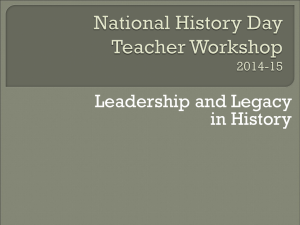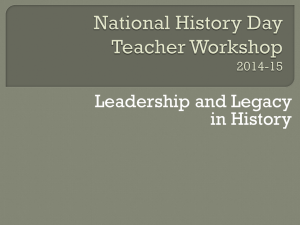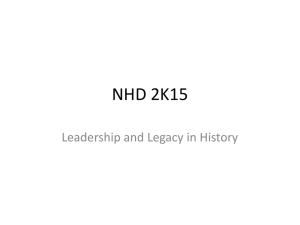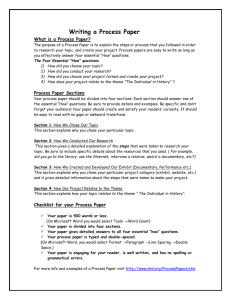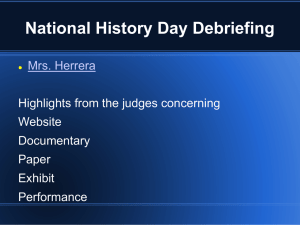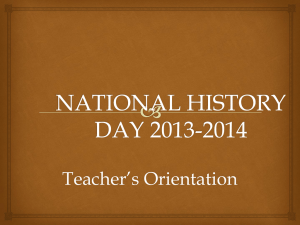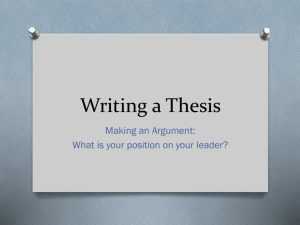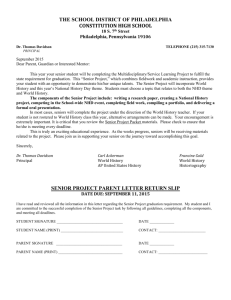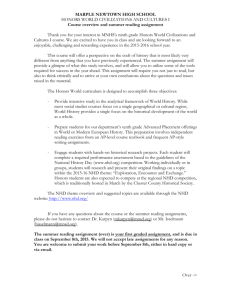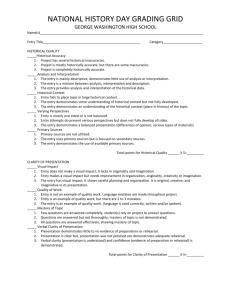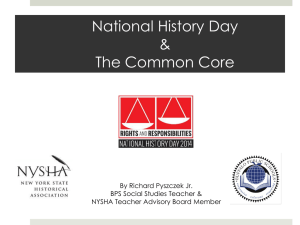HISTORY FAIR AND YOU
advertisement
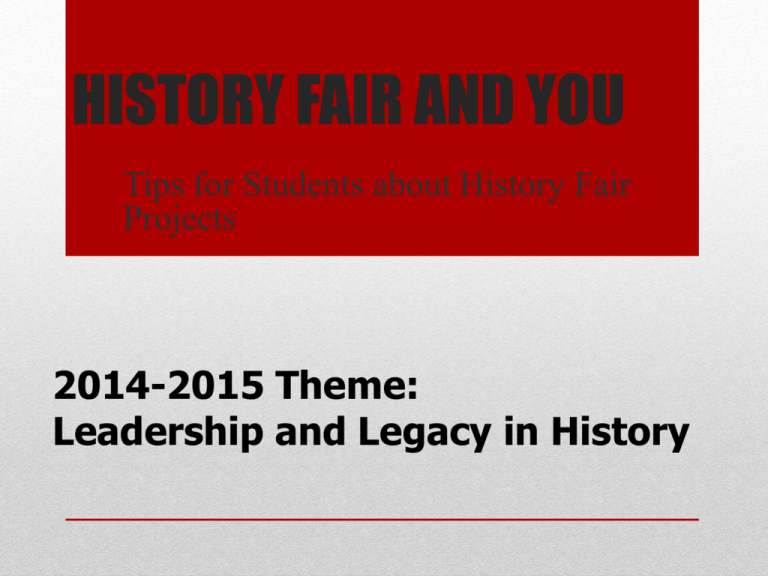
HISTORY FAIR AND YOU Tips for Students about History Fair Projects 2014-2015 Theme: Leadership and Legacy in History WHAT IS HISTORY FAIR? • What is the National History Day Contest, you ask? Each year more than half a million students just like you participate! • You will choose a historical topic related to the annual theme, and then conduct primary and secondary research. • You could look through libraries, archives and museums, conduct oral history interviews, and visit historic sites. • After you have analyzed and interpreted your sources, and have drawn a conclusion about the significance of your topic, you will then be able to present your work in one of five ways: as a paper, an exhibit, a performance, a documentary, or a web site. • The NHD website has tons of information: www.nhd.org Competition Time! In round one, you may enter your work into your school NHD contest where it will be judged. If your work is chosen as one of the best, you will compete in the Lee Regional History Fair in March. If your work is chosen as one of the best at Lee Regionals, you will move on to your state's NHD contest. State contest is held in Austin, Texas in May. If you are a winner at your state NHD contest, you will be eligible to attend the Kenneth E. Behring National History Day Contest at the University of Maryland at College Park in June. This is where the best National History Day projects from across the United States, American Samoa, Guam, International Schools and Department of Defense Schools in Europe all meet and compete. WHAT is the THEME? This year’s theme is Leadership and Legacy in History. What exactly is Leadership? Leadership is the act of leading: providing motivation, guidance or direction, usually from a position of authority. Leadership takes many forms. You might immediately think about presidents and kings as leaders, but what about local community representatives and organizers? How about religious leaders, governors, mayors, or business owners? Some leaders are elected, others are appointed, and some seize a position of authority. When it comes to monarchies, some leaders inherit their positions. Consider the leadership that it takes for a small group of people to come together to accomplish a common goal, fight for rights, or social change. Sometimes a leader emerges because he or she happens to be in the right place at the right time. Not all leaders have been seen as positive, some are identified as destroyers or tyrants versus leaders. WHAT IS A LEGACY? • Looking carefully at the impact on society and change over time, you will also need to think about the leader’s legacy. Legacy is what is handed down to us from our ancestors or predecessors. More broadly, legacy is what is left behind for future generations—such as ideas and accomplishments. • Sometimes a legacy depends on perspective. Not all legacies are positive ones. What happens when leadership goes awry? Legacies also can be controversial. Events can lead one group of people to feel that a leader was a great and moral influence who facilitated a positive outcome, while a different group of people believe exactly the opposite. 1. Understand there is a theme. 2. Pick something that is interesting to you. 3. Pick a topic.. Something to do with your interest. 4. Narrow your choice down to a particular issue. Theme: Leadership and Legacy Interest: Worker’s Rights Topic: Cesar Chavez Issue: UFW and the Salad Bowl Strike OR Theme: Leadership and Legacy Interest: India Topic: Protest for Freedom Issue/Events: Quit India Movement OR Theme: Leadership and Legacy Interest: Female Leaders Topic: Social Mistreatment Issue: Mother Theresa’s Missionaries of Charity CHOOSING A TOPIC • Exhibit – Individual or Group • Historical Paper - Individual only • Performance - Individual or Group • Documentary – Individual or Group • Website- Individual or Group CHOOSING PROJECT PRESENTATION • CAN BE EITHER INDIVIDUAL OR GROUP (MAXIMUM OF 5) • AN EXHIBIT IS A VISUAL REPRESENTATION OF YOUR TOPIC • EXHIBIT IS TYPICALLY EITHER A PAPER OR WOODEN TRI-FOLD BOARD • PICTURES, MAPS, DIAGRAMS DESCRIBE YOUR TOPIC • TEXT TO EXPLAIN CONCEPTS– YOU CAN CREATE 500 OF YOUR OWN WORDS AND CAN USE QUOTES FROM OTHERS Exhibit • 1,500-2,500 WORDS (8- 10 PAGES OF TYPED INFORMATION) • TYPICALLY A FORMAL PAPER, BUT CAN BE PORTRAYED USING CREATIVE WRITING SUCH AS A FICTIONAL DIARY OR POEM • CITATIONS (FOOTNOTES OR ENDNOTES) ARE REQUIRED • INDIVIDUAL CATEGORY ONLY- NO GROUP PAPERS ARE PERMITTED Paper • INDIVIDUAL OR GROUP (MAXIMUM OF 5 STUDENTS) • NO LONGER THAN A 10 MINUTE PERFORMANCE • STUDENTS CREATE SCRIPT BASED ON HISTORICAL RESEARCH, LEARN LINES, CREATE THE SET, AND CONSTRUCT COSTUMES. Performance • INDIVIDUAL AND GROUP (MAXIMUM OF 5 STUDENTS) • MOVIE MUST BE LESS THAN 10 MINUTES • STUDENTS PRODUCE A MINI-MOVIE: NEED TO HAVE TECHNOLOGY SKILLS TO DO THIS CATEGORY. A COMPUTER AT HOME IS REALLY IMPORTANT. • YOU WILL ADD SOUND, PICTURES, AND VOICE OVERS Documentary • INDIVIDUAL OR GROUP CATEGORY (MAXIMUM OF 5) • MUST USE THE NHD.WEEBLY WEBSITE • ADD TEXT, MOVIES, DOCUMENTS, QUOTES • MEDIA (MOVIES) MUST BE LESS THAN 45 SECONDS Websites CONDUCTING RESEARCH • Begin with an outline… Ask yourself 10-15 questions that will guide your research. • Use note cards (either paper or electronic) to keep up with your information. Make sure you are identifying your source of information so that you can go back to the source later. CONDUCTING RESEARCH • Then start READING secondary sourcesGet an overview of the circumstances, then move to primary sources. Secondary Sources – A source that seeks to explain or interpret an event written by someone such as a historian decades or even centuries after the event. - Books - Articles - Interviews that explain or interpret – the person is talking about an event and was not a participant - Media productions SECONDARY SOURCES Primary Sources – Information created by the event or the process of an event - Archival documents (Government Documents) Manuscripts and/or diaries Photographs Newspapers, magazines, journals if they are written at the time of an event - Personal interviews if the person participated or was an eyewitness PRIMARY SOURCES RESEARCH • Research should be balanced: Type: You should not have just internet sources, or just books. Try to balance your type of sources. • Research should be balanced: Quality: You should locate information that you know is accurate from reliable sources. Not everything on the internet is always true! • Research should be balanced: Bias: If you read / present information from one side of the argument, you should do the same with the other. • Research should be balanced: Primary / Secondary: Try to support your primary source documents with secondary sources and vice versa. RESEARCH These are just some of the websites that contain reliable information: http://chroniclingamerica.loc.gov http://www.loc.gov http://www.history.com http://www.archives.org http://www.si.edu http://www.pbs.org/ http://www.c-spanclassroom.org/ http://www.teachersdomain.org/special/civil/ RESEARCH Our district databases are beneficial to conduct both primary and secondary research: District Database Relevance AP Photos Modern and Historical Primary Source Photos ABC-Clio Historic American and World History Gale A resource center that searches magazines, newspapers, and reference books. SIRS A general reference database containing thousands of full-text articles that explores social, scientific, health, historic, business, economic, political, and global issues. WorldBook Online encyclopedia that provides great background information American West New database that provides source information about the American West American Indian Histories and Cultures Another new database that covers information about American Indian Histories and Cultures. Domain ending example .edu = educational institution http://docsouth.unc. edu .gov = US government site http://memory.loc. gov .org = organization or association http://www.theaha. org .com = commercial site http://www.historychannel. com .museum = museum http://nc.history. museum .net = personal or other site http://www.californiahistory. net Website Identification Your project should… Create a strong, interesting, and persuasive thesis statement, then provide information to support that statement. Remember that you are the expert on your topic. Make sure your project is clear and to the point. Read through your information and make sure that you can understand the material. If you can not understand the material, no one else will be able to either. • Use primary research and show that these sources have been used - Use quotes, pictures, and headlines from the sources. • Use secondary sources help to support the primary sources • Make sure materials used are part of the “story” and help prove your thesis. You should not place random pictures throughout your project without knowing how they tell your story. Showing Results of Research • Provide annotations for each source by describing the source and what was learned from it – be specific about the quality of the help, what you learned from the source, and where it was used • Choose one type or style for citing sources that your teacher provides for you. Noodletools or Easy Bib are both great online bibliography citation machines. BIBLIOGRAPHY Historical papers do not need a process paper All other categories require a process paper The process paper is limited to 500 words. The information presented on the process paper includes: 1. How you chose your topic 2. How you conducted your research 3. How you selected your presentation category and created your project 4. How your project relates to the NHD theme. Process Paper Criteria for a quality history project Historical Quality (60%) Historically Accurate Shows analysis and interpretation Shows wide research Uses available primary sources Research is balanced in relation to various points of view Relation to the Theme (20%) Clarity of Presentation (20%) • http://www.nhd.org/StudentProjectExamples.htm NHD EXAMPLE PROJECTS
